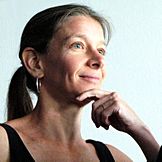Judith Donath facts for kids
Quick facts for kids
Judith Donath
|
|
|---|---|

Judith Donath giving a talk at the EPFL, on June 22, 2009
|
|
| Born | May 7, 1962 |
| Nationality | American |
| Alma mater | MIT Yale University |
| Known for | Educational software designer and builder, Social media research, Virtual world architect |
| Scientific career | |
| Fields | Media Arts, Human–computer interaction, History |
| Institutions | MIT |
| Thesis | Inhabiting the virtual city: The design of social environments for electronic communities (1997) |
| Doctoral advisor | Andrew B. Lippman |
| Doctoral students |
|
Judith Stefania Donath (born May 7, 1962) is a well-known American researcher. She works at Harvard's Berkman Center. She also started the Sociable Media Group at the MIT Media Lab.
Judith Donath writes about how the internet affects society. Her work covers topics like online communities and how people act in virtual worlds. She also studies how we use different online identities.
Contents
Exploring Online Identity
Donath's research often looks at "identity and deception in online communities." She studies how people might pretend to be someone else online. She also explores how we create different online personalities.
In 1999, she studied how people used fake identities on Usenet. She also looked at how someone's personality could be understood. This was done by gathering information from both online and offline interactions.
Her Amazing Career
Judith Donath earned her first degree in history from Yale University. She then got her master's and Ph.D. degrees from MIT. Her studies focused on media arts and sciences. She has designed and built educational software. She also creates experimental media projects.
Early Internet Projects
On October 10, 1995, Donath helped organize a big event. It celebrated the tenth birthday of the MIT Media Lab. She came up with a huge online project. People from all over the world worked together to build a large website.
This event was called A Day in the Life of Cyberspace. It was one of the first examples of many people working together online. This is now known as mass collaboration.
Her early and important work includes The Electric Postcard. This was the very first online postcard service. She also created Portraits in Cyberspace. This was the first interactive art show.
Art and Virtual Worlds
More recently, Donath directed an art show called Id/Entity. This exhibit explored how modern computers change portraiture. It showed how new technology can transform how we see faces.
In her 2000 book, Being Real, Donath looked at how we understand things in virtual worlds. She explored how humans interact with computer-controlled characters, called avatars.
Social Media and Connections
Donath has also studied how social media affects society. She looked at how these platforms show our connections to others. She calls this "Public Displays of Connection." Her work on sociable media helps us understand semiotics. Semiotics is the study of signs and symbols.
Robots and Online Cities
When it comes to telerobotics, Donath has an interesting idea. Telerobotics means controlling robots from far away. She thinks this might make us less sensitive. This is because we don't see the people the robot is interacting with.
She has also studied the ethnography of online communities. This means she looks at the cultures and customs of groups of people online.
Her work also includes applying ideas from architectural design. She uses these ideas to create online communities. She imagines these communities as a kind of virtual city.
Avatars and Advertising
Donath has explored using artificial emotions in avatars. She thinks these emotions could be used in online advertising. She believes avatars might have many different "emotions." They could choose the right emotion to "wear" for different situations. This would help them connect better with the people they are trying to reach.
In her essay "Mediated Faces," she discusses how faces are shown online. She suggests that computers can create many new ways to show faces. It's more than just a simple picture.
She has also compared online flaming to real-life vandalism. Flaming is when people are rude or aggressive online. She notes that both can happen anonymously.
Donath spoke at the Wikimania conference in August 2006. She talked about identity, anonymity, and wikis. She later returned to Harvard University as a Fellow at the Berkman Center for Internet & Society.
Selected Publications
- Donath, Judith: Identity and Deception in the Virtual Community. In M. Smith and P. Kollock (eds.) Communities in Cyberspace. London: Routledge, 1998
- Fernanda Viégas, Judith Donath: Chat Circles. ACM Conference on Computer-Human Interaction (CHI), 1999
- Judith Donath, Karrie Karahalios, Fernanda Viégas: Persistent Conversations. Journal of Computer Mediated Communication 4 (4), 1999
- Donath, Judith: Being Real. In (K. Goldberg, ed.) The Robot in the Garden: Telerobotics and Telepistemology in the Age of the Internet. Cambridge, MA: MIT Press, 2000
- Donath, Judith: 1964 Ford Falcon. In (Turkle, S., Ed) Evocative Objects: Things We Think With. Cambridge, MA: MIT Press, 2007
- The Social Machine: Designs for Living Online (The MIT Press), 2014, ISBN 978-0262027014

